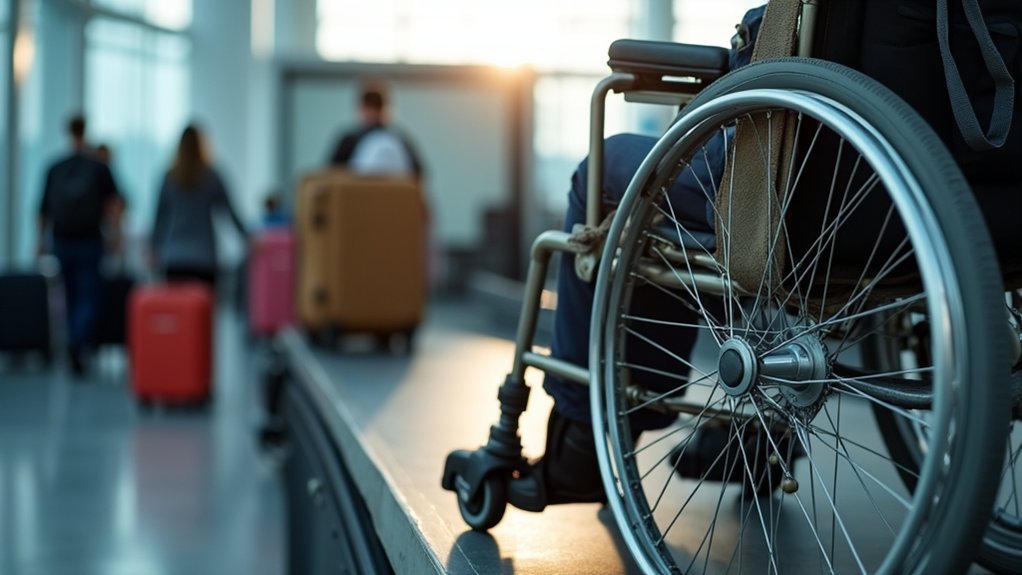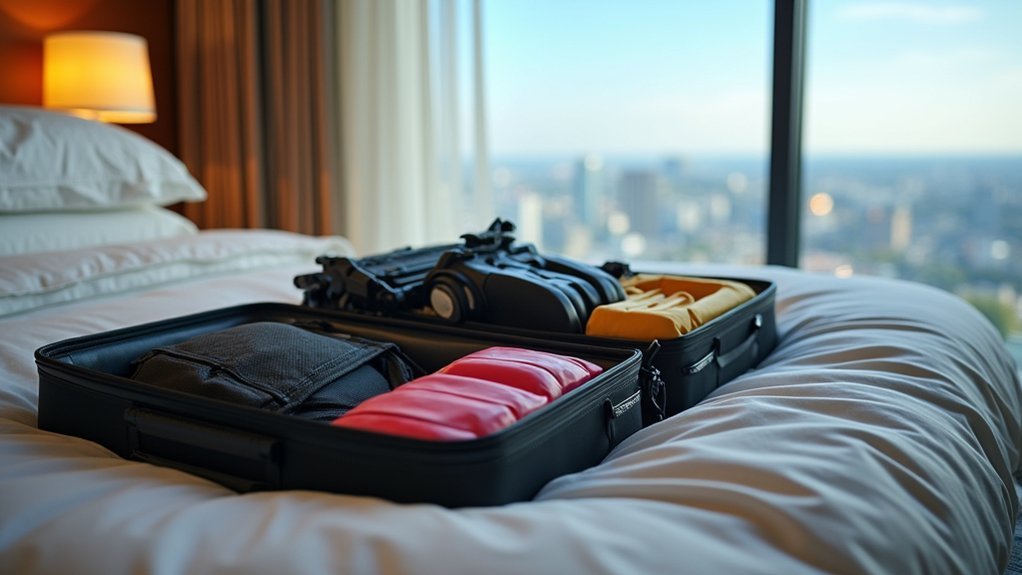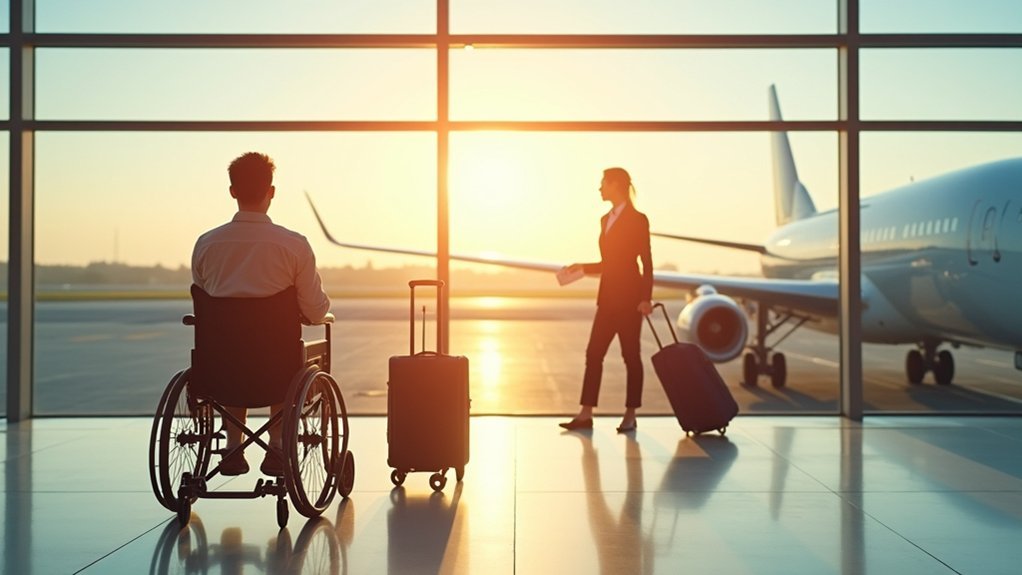When flying with a wheelchair, always photograph your chair before checking it, use bubble wrap on sensitive components like joysticks, and remove detachable parts to prevent damage. Know your rights under the Air Carrier Access Act and communicate your needs to airlines at least 72 hours ahead, especially for oxygen requirements. Pack repair tools, spare parts, and extra batteries to handle common issues independently. These strategies will help you navigate air travel challenges while maintaining your mobility independence.
Securing Your Wheelchair During Transit: Strategies to Prevent Damage

When flying with a wheelchair, protecting your mobility device from damage requires careful planning and preparation.
Remove detachable parts like side guards, armrests, and cushions to carry with you onboard. These components are easily lost or damaged during handling.
Take removable wheelchair components on board with you to prevent loss and damage during flight handling.
Protect sensitive parts by wrapping joysticks, control panels, and screens with bubble wrap or specialized padding. Use pipe insulation to shield exterior surfaces from scratches.
Verify your wheelchair is properly tagged and communicate specific handling requirements to airline staff before your flight.
Request cabin storage when possible, or inquire about the seat strapping method on compatible aircraft. For gate-checked wheelchairs, explain proper handling procedures to ground staff.
Take photos of your wheelchair before departure as documentation in case you need to file a damage claim later.
If damage does occur during your flight, immediately contact the airline’s Complaint Resolution Official before leaving the airport to ensure proper documentation and assistance.
Advocating for Yourself: How to Navigate Airline Accommodations
Beyond protecting your wheelchair, successful air travel requires a thorough understanding of your rights and how to advocate for proper accommodations. The Air Carrier Access Act prohibits airlines from discriminating against passengers with disabilities and mandates equal treatment during air travel.
Communicate early with airlines about your needs. For electric wheelchairs on small planes, check in advance. International flights require 72 hours’ notice for carrier-supplied oxygen. Under the new DOT rule, you have the right to receive timely assistance for boarding, deplaning, and making connections between flights.
If your wheelchair doesn’t fit on your original flight, you’re entitled to fare difference reimbursement and rebooking at no additional cost.
If issues arise, document everything. You can file complaints with the Department of Transportation for discrimination or inadequate service.
Remember that airlines must provide loaner mobility devices when necessary and explain any accommodation refusals.
Packing Essentials: Equipment Backup Plans and Emergency Solutions

Every successful wheelchair traveler knows that thorough preparation prevents most travel disasters. When packing for air travel, prioritize backup equipment and emergency supplies to guarantee uninterrupted mobility throughout your journey. Consider bringing a portable ramp to access non-wheelchair accessible locations during your travels.
| Essential Category | Must-Have Items | Why It Matters |
|---|---|---|
| Power Supplies | Extra batteries, chargers, voltage adapters | Prevents being stranded with dead equipment |
| Repair Tools | Allen keys, screwdrivers, tire repair kit | Enables quick fixes for minor breakdowns |
| Spare Parts | Tire tubes, casters, cushions | Replaces commonly damaged components |
| Medical Supplies | Pressure sore kit, catheters, medications | Addresses specific health needs away from home |
| Documentation | Service records, prescriptions, emergency contacts | Facilitates security checks and emergency care |
Always label your equipment clearly and coordinate with airline staff in advance to minimize handling issues with your mobility devices.
Frequently Asked Questions
Can I Pre-Board if I Use a Wheelchair?
Yes, you can pre-board if you use a wheelchair. Airlines offer this option to give you extra time for seating and storing your mobility aid before other passengers board the plane.
How Early Should Wheelchair Users Arrive at the Airport?
You should arrive at least 3 hours before international flights and 2 hours before domestic flights. If you use a battery-powered wheelchair, add an extra hour to guarantee smooth check-in and assistance arrangements.
Are Airport Lounges Typically Accessible for Wheelchair Users?
Yes, most airport lounges are wheelchair accessible with adapted restrooms, comfortable seating, and staff assistance. You’ll find ramps, wide doorways, and sufficient space to navigate your wheelchair comfortably throughout these premium spaces.
Do All International Airports Offer the Same Wheelchair Accessibility Standards?
No, you’ll find significant variations in wheelchair accessibility across international airports. Standards aren’t uniform globally, with differences in terminal design, assistance services, and infrastructure due to varying regional regulations and implementation.
Can I Request Specific Seating Accommodations for My Disability?
Yes, you can request specific seating accommodations for your disability. Airlines must provide appropriate seating when you notify them at least 24 hours before your flight under the Air Carrier Access Act’s requirements.
In Summary
By mastering wheelchair security, assertive self-advocacy, and strategic packing, you’ve equipped yourself with essential skills for smoother air travel. These strategies won’t eliminate every challenge, but they’ll considerably reduce stress and potential complications. Remember, you’re entitled to accessible travel experiences. Don’t hesitate to speak up, plan ahead, and protect your equipment. With these tactics, you’re ready to navigate the skies with greater confidence and independence.





Leave a Reply